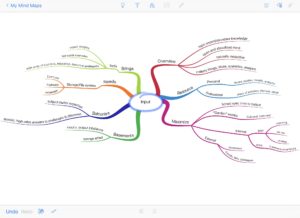Last month I had the privilege to speak to 175 executives, educators and strengths advocates at the CliftonStrengths Summit about leveraging the power of mind mapping to focus our natural talents.
Here are the key takeaways from the workshop to help you aim your unique strengths on your personal and professional goals.
What Is Mind Mapping And Why Is It So Effective?
The human brain is constantly using associations and triggers to connect information and ideas.
X-ray, potato chips, the stethoscope, microwave ovens and even the hypnotic slinky were all invented because someone connected an association—sometimes vague, sometimes explicit—with an idea.
Mind mapping is a simple and effective visual diagram used to capture and organize ideas and information. It’s a brain-friendly tool to help you get the unique brilliance out of your head and into the world.
Moreover, mind mapping is effective because it mirrors the way our brains function—in a radiant way rather than a linear way.
Plus, it’s really easy.
Here’s how you do it.
Mind Mapping In 3 Steps
Take a piece of paper and turn it horizontally so your mind map is in “landscape” orientation. This gives you plenty of space to let your brain rapidly expand on all of your unique associations and triggers.
1. Write the central idea, issue or challenge in the middle of the paper. Keep it simple, preferably one word.
For my example below, I mind map the Input talent theme from Amazon’s #1 selling non-fiction book of all-time, StrengthsFinder 2.0.
2. As we reflect on our central idea, our minds naturally begin connecting insights and information from our lives, work, relationships, hobbies, travel, education, training, and personal experiences and insights.
Quickly capture each new association by drawing branches extending out from the central idea. Each new branch begins forming a “map” to the central idea.
This radiating process is natural to how your brain already processes information.
Let the randomness of these connections flow on to the paper, even if they may seem arbitrary in the moment. This is part of the beauty and power of mind mapping. Our mind can render hidden solutions we didn’t even know we had if we let it.
3. As we extend these initial branches out from the central idea, more ideas and information will collide, combine and emerge. Keep expanding on these secondary ideas by adding sub-branches onto your main branches.
Here’s what my initial talent theme mind map looks like using iMindMap software on my iPad.
Pretty simple, right?
Simple, yet powerful.
Just The Beginning
This one mind map gets many different insights (talent theme balconies, basements, brings, needs, ways to maximize, etc.) into a structured but fluid format.
Plus, it took less than ten minutes.
No, I haven’t completely unpacked the depth and richness of the Input talent theme yet. However, I now have a dashboard display full of burgeoning associations, triggers, ideas and information. I can continue building and expanding on this central idea as much as I want.
Here’s where mind mapping gets really cool.
There are hundreds of ways you can use mind maps to brainstorm and create better outcomes.
Here are just a few:
• Plan, organize and prioritize events, initiatives and strategy
• Boost memory and enhance learning on any topic
• Encourage critical thinking and problem-solving
• Prepare classroom curriculum, improve academic performance and executive education
• Enhance writing and presentation preparation
• Streamline processes and procedures
• Promote collaboration and teamwork
From Knowledge To Action—Summit Mind Mapping Prompts
Part of the secret power of a good tool is how creatively you deploy it.
Do yourself a favor. Take fifteen minutes and mind map the same prompts we explored in the workshop in Omaha. Give yourself at least five minutes on each prompt.
By harnessing the radiant way your mind naturally works, I guarantee you’ll come up with new insights about yourself, your work and your life.
Prompt #1 — Consider one of your dominant talent themes you feel you may not be fully maximizing.
Why are you not fully leveraging one of your signature talents? What barriers, if any, are preventing you from using it? What actions can you take today to begin addressing this?
Mind map how you can better use this specific talent to achieve your goals.
Prompt #2 — What is your biggest coaching, work, or business challenge at this very moment?
Mind map it. Explore why you may be struggling to address this challenge. What steps you can take to begin resolving it?
Bonus points for discovering creative ways to use your natural strengths to address the challenge.
Prompt #3 — Mind map your most pressing current personal challenge.
Use your mind map to untangle this personal challenge. Get to the real root of the issue, and establish a path forward.
If you need some thought starters, revisit Tom Rath’s 5 Elements of Wellbeing (Career, Social, Financial, Physical and Community).
I’ve had a blast hearing about all of the workshop attendee mind map discoveries since the summit. If you discover any super cool insights from mind mapping these prompts, please feel free to drop me a line at hello@strengthslauncher.com.
A few focused minutes of thoughtful reflection and mind mapping can illuminate any topic—personal or professional—and help you achieve better results.
Good luck!
Final Mind Mapping Tips and Resources
• Feel free to draw quick sketches instead of using text or words. Think stick figures and simple icons, not Louvre-worthy portraiture.
• Use curved lines for your branches and sub-branches. Straight lines are boring to the brain.
• If you want to use color, go for it. Again, quick doodles, curved lines and color make the mind map more interesting and engaging to your brain.
• Don’t get bogged down in too much self-editing. Just get the ideas on the page. We don’t need perfect penmanship or design symmetry here. We’re aiming for speed and volume.
• Have fun, use your imagination and boost your productivity!
iMindMap software* – I personally use this software. The premium version I have on my iPad costs around $20 annually. It’s pretty user friendly, and the controls are intuitive.
Biggerplate – Large mind map library and community.
Why mind maps are key to mindfulness and idea generation
*I do not and have not received any payment to mention, recommend or link to this product.
If you’ve never taken the StrengthsFinder assessment, do yourself a favor and check it out here. Discover your natural talents and put them into action today.
If you enjoyed this post, please sign up for future tips and insights on turning your talents into strengths at StrengthsLauncher.
Share this Post


